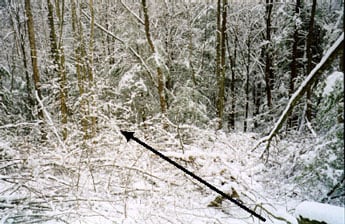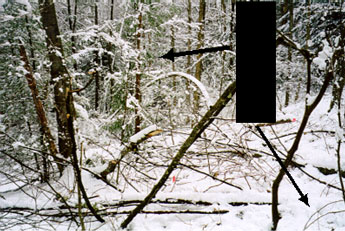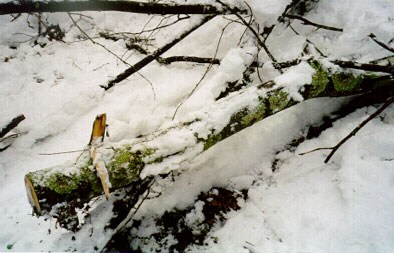Tree Feller Dies After Being Struck by Limb of Tree Being Felled in West Virginia.
Case: 99WV005-01
Release Date: July 19, 1999
SUMMARY
On December 1, 1998, a 25-year-old male tree feller (the victim) died of injuries sustained when he was struck on the head by a limb which had snapped off of the tree he was felling as the tree impacted the ground. The victim was felling trees on terrain with an average 35% slope. He was in the process of felling a yellow poplar. The poplar was approximately 24 inches in diameter at breast height and 90 feet tall. The tree was non-typical in that it had a large, 65-foot-long limb which was 18 feet above the ground. The limb was approximately 6 inches in diameter at the point of attachment and was oriented 90 degrees to the tree’s trunk. The limb was pointing directly downhill, which was also the direction of the felling. After making the final cut, the victim retreated approximately 21 feet from the stump at an angle close to 45 degrees uphill from the cutting side. The victim was hit on the back of the head with the tapered end of the limb as it flipped back uphill towards the logger. A dozer operator discovered the victim shortly after the incident and notified the owner. The owner administered first aid and CPR. Another worker ran to a local residence and contacted EMS. The victim was life-flighted to the local trauma center and died the next day.
The WV FACE Investigator concluded that, to reduce the likelihood of similar occurrences, employers should:
- ensure that tree fellers properly evaluate the timber and the area around the timber to be felled so that potential hazards can be identified and appropriate control measures implemented.
- develop, implement, and enforce a written safety program which includes, but is not limited to, training in hazard identification, avoidance, and abatement.
- designate a competent person to conduct frequent and regular site safety inspections.
INTRODUCTION
On December 1, 1998, a 25-year-old male tree feller (the victim) died of injuries sustained when he was struck on the head by a limb which had snapped off of the tree he was felling as the tree impacted the ground. On January 4, 1999, the West Virginia FACE Investigator was notified of the death by the West Virginia Department of Health and Human Resources via a death certificate. On February 26, 1999, the WV FACE Investigator conducted an on-site investigation. The Investigator reviewed the incident with the West Virginia Division of Forestry representative, who then accompanied the Investigator to the site. The timber procurement company’s forester was interviewed. The logging company’s owner also responded to a series of questions. The incident site was examined and photographed. Other informational sources and contacts included: death certificate, medical examiner’s report, newspaper articles, West Virginia Division of Forestry, and the National Weather Service.
The employer in this incident was a commercial logging company that had been in business for eleven years and employed three employees. The owner and three employees were present the day of the incident. The land was industry-owned. The unmarked, 20 acre timber stand was being selectively logged for saw timber. It was reported that operation was on schedule.
The owner held Certified Logger status in West Virginia. [Note: The Logging Sediment Control Act of West Virginia (1992) requires that each timbering operation in West Virginia be supervised by a certified logger. To become a certified logger, an individual is required to successfully complete training and pass a test for best management practices (a soil erosion prevention plan) and chain saw safety and possess a current first aid card.1]
The company had no written safety program. The employer (owner) did not indicate that formal company-specific training was provided. It was reported that the owner would counsel his workers in a preventative manner as well as corrective manner when necessary. The employer had never experienced a similar incident, and no fatalities had occurred in the company.
The victim’s job at the time of the incident was felling trees. He had been a logger for four years. The victim had been cutting for the employer for a total of two months when the incident occurred. He had attended the West Virginia Division of Forestry’s chain saw safety workshop. At the time of the incident, the victim was wearing a hard hat, eye protection, hearing protection, chaps, gloves, and boots. He had been cutting 6 ½ hours prior to the incident.
INVESTIGATION
On December 1, 1998, the company was selectively harvesting the tract and had begun work at approximately 8:00 a.m. It was reported by the National Climatic Data Center within the area to be a dry day. There was no snow on the ground the day of the incident. The owner and three employees were working that day. At approximately 3:00 p.m., the victim approached a yellow poplar located adjacent to a skid road on the uphill side. The terrain above the skid road at the incident site was sloped approximately 25 %; below the road was 40%. The poplar was approximately 24 inches in diameter at breast height and 90 feet tall. The tree had a large 65-foot -long limb which was 18 feet above the ground at the tree’s base. The limb was approximately 6 inches in diameter at the point of attachment and was oriented 90 degrees to the tree’s trunk. The limb was pointing directly downhill, which was also the intended direction of the felling. The victim implemented a standard open notched cut with a near perfect hinge. The hinge had directed the tree to the desired opening across the skid road (see Figure 1). The tree did not contact any other timber during its fall. After making the final cut, the victim retreated approximately 21 feet from the stump at an angle close to 45 degrees uphill from the cutting side along a previously established deer trail (see Figure 2). The victim was hit on the back of the head with the tapered end of the limb as it folded under or flipped back uphill towards the logger (see Figure 3). A dozer operator discovered the victim shortly after the incident and notified the owner. The owner administered first aid and CPR. Another worker ran to a local residence and contacted EMS. The owner continued administering CPR for nearly one hour until EMS arrived. The site was extremely remote. The victim was life-flighted to the local trauma center and died the next day. The victim experienced a severe injury to the back of the head. He was wearing a hard hat at the time of the incident.
CAUSE OF DEATH
The medical examiner’s report listed the immediate cause of death as head injury.
RECOMMENDATIONS/DISCUSSION
Recommendation #1: Employers should ensure that tree fellers properly evaluate the timber and the area around timber to be felled so that potential hazards can be identified and appropriate control measures implemented.
Discussion: Two potential hazards existed which contributed to this incident. The tree had a non-typical growth pattern which produced a 65-foot long limb positioned relatively close to the ground (18 feet above grade), which in turn had grown perpendicular to the trunk and was pointing downhill. Additionally, the terrain below the tree was unevenly sloped due to natural formation and the presence of the skid road. Timber with limbs whose lengths are longer than the vertical distance from the ground to limb attachment can be hazardous. In this case, folding the limb backwards towards the feller would have allowed the limb to extend approximately 47 feet behind/past the stump. As a throwback, the limb’s length well exceeded the distance from notch to limb’s attachment point. A limb which is close to the ground will contact the ground sooner during felling, shortening both throwback distance to the feller and the feller’s reaction time. Throwbacks are more likely to occur when the terrain is uneven. Before each tree is felled, conditions such as, but not limited to, snow and ice accumulation, the wind, the lean of the tree, dead limbs, and location of other trees, shall be evaluated by the feller and precautions taken so a hazard is not created. Additionally, fellers should consider the relationship between limb length and limb height. In this case, it appears the victim may not have considered the potential reach of the limb should a foldback or throwback occur. Appropriate precautions (e.g., removing the limb first with a pole chain saw) may have been implemented, thereby eliminating the potential hazard. Given the length of the limb and the close proximity to the ground, in conjunction with the uneven terrain, an appropriate decision may have been to consult with a supervisor before cutting and/or eliminating the poplar tree from those chosen for cutting.
Recommendation #2: Employers should develop, implement, and enforce a written safety program which includes, but is not limited to, training in hazard identification, avoidance, and abatement.
Discussion: The evaluation of tasks to be performed at the work site form the basis for the development, implementation, and enforcement of a safety program. The key elements of the program should include, at a minimum, training in hazard identification and the avoidance and abatement of these hazards. In particular, the program should address the steps to be taken in the event of identifying a non-routine hazard. In this incident, the victim was struck and killed by a non-typical limb that had snapped off as the tree contacted the ground. Safety precautions including proper tree cuts and the use of an escape path were made; however, hazards created by the non-typical tree formation should have been recognized and the necessary steps addressed, such as notifying the certified logger, limb removal or the elimination of the tree from the harvesting process to ensure maximum safety for workers.
Recommendation #3: Employers should designate a competent person to conduct frequent and regular site safety inspections.
Discussion: Conducting regular safety inspections of all logging operations by a company- appointed competent person, who has the ability to identify hazards and the authority to take prompt corrective action, will help ensure that established company safety procedures are being followed. In addition, scheduled and unscheduled inspections clearly demonstrate to the employees that the employer is committed to the safety program and to the prevention of occupational injury. Frequent inspections increase the likelihood the hazards will be recognized. Then, prompt corrective action can be taken. In this incident the competent person may have decided to eliminate this tree from the cutting if safe limb removal could not be accomplished prior to the tree felling.
REFERENCES
- West Virginia Logging Sediment Control Act, 1992.
ILLUSTRATIONS
 |
|
Figure 1. Clearing below skid road and direction of fell.
|
 |
|
Figure 2. Direction of felling and utilized escape route. Lower arrow point indicates approximate position of victim when struck by limb. Path was clear of limbs at the time of the incident.
|
 |
|
Figure 3. Mid section of the limb which struck the victim. Section which struck the victim was approximately three inches in diameter.
|
FATALITY ASSESSMENT AND CONTROL EVALUATION PROGRAM
The WVU Center for Rural Emergency Medicine, through a contract with the West Virginia Department of Health and Human Resources, conducts investigations on the causes of work- related fatalities within the state. The goal of this program is to prevent future fatal work-place injuries. West Virginia FACE intends to achieve this goal by identifying and studying the risk factors that contribute to work-place fatalities, by recommending intervention strategies, and by disseminating prevention information to employers, employees, trade associations, unions, equipment manufacturers, students, teachers, and others with an interest in work-place safety.
Please use information listed on the Contact Sheet on the NIOSH FACE website to contact In-house FACE program personnel regarding In-house FACE reports and to gain assistance when State-FACE program personnel cannot be reached.
